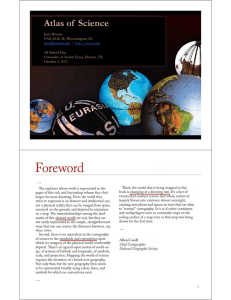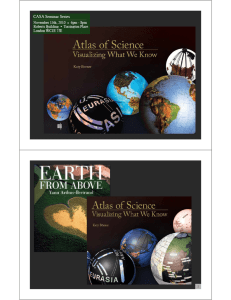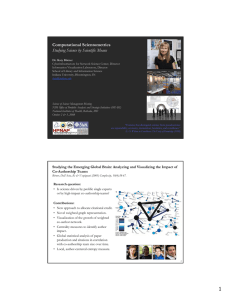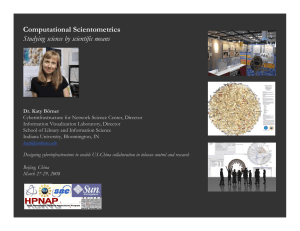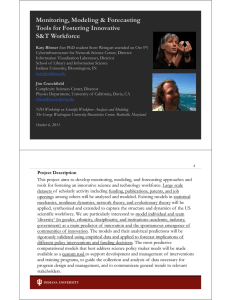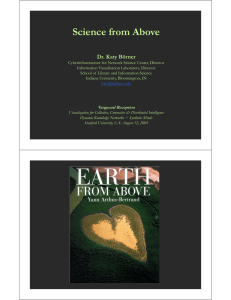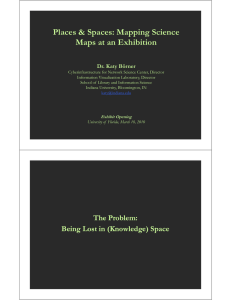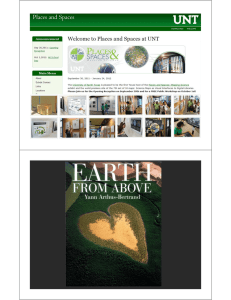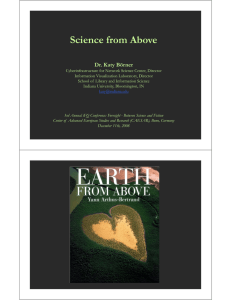Places & Spaces: Mapping Science An International Exhibit
advertisement
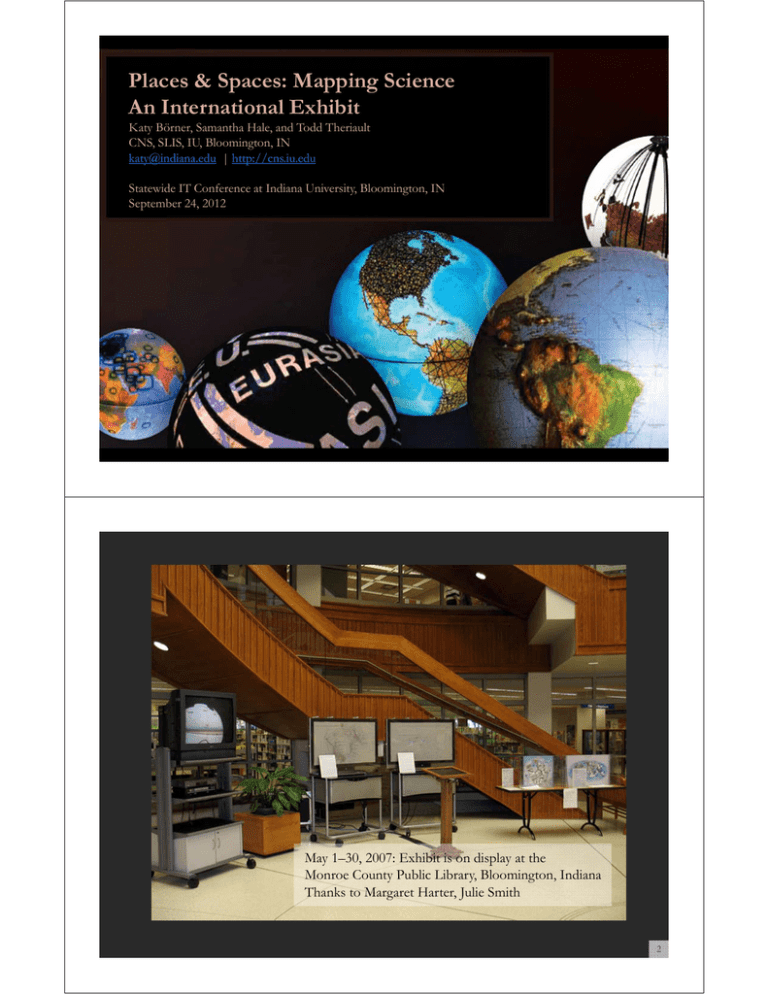
Places & Spaces: Mapping Science An International Exhibit Katy Börner, Samantha Hale, and Todd Theriault CNS, SLIS, IU, Bloomington, IN katy@indiana.edu | http://cns.iu.edu Statewide IT Conference at Indiana University, Bloomington, IN September 24, 2012 May 1–30, 2007: Exhibit is on display at the Monroe County Public Library, Bloomington, Indiana Thanks to Margaret Harter, Julie Smith 2 May 1–30, 2007: Exhibit is on display at the Monroe County Public Library, Bloomington, Indiana Thanks to Margaret Harter, Julie Smith 3 4 Find your way Black Box Find collaborators, friends Take terra bytes of data Identify trends 5 6 7 8 14 15 19 22 24 25 Illuminated Diagram Display W. Bradford Paley, Kevin W. Boyack, Richard Kalvans, and Katy Börner (2007) Mapping, Illuminating, and Interacting with Science. SIGGRAPH 2007. Questions: Who is doing research on what topic and where? What is the ‘footprint’ of interdisciplinary research fields? What impact have scientists? Large-scale, high resolution prints illuminated via projector or screen. Interactive touch panel. Contributions: Interactive, high resolution interface to access and make sense of data about scholarly activity. 26 27 28 Science Maps in “Expedition Zukunft” science train visiting 62 cities in 7 months 12 coaches, 300 m long Opening was on April 23rd, 2009 by German Chancellor Merkel http://www.expedition-zukunft.de 29 30 31 32 33 Science Puzzle Map for Kids by Fileve Palmer, Julie Smith, Elisha Hardy and Katy Börner, Indiana University, 2006. (Base map taken from Illuminated Diagram display by Kevin Boyack, Richard Klavans, and W. Bradford Paley.) 34 35 36 Mapping Science Exhibit – 10 Iterations in 10 years http://scimaps.org/ The Power of Maps (2005) Science Maps for Economic Decision Makers (2008) The Power of Reference Systems (2006) Science Maps for Science Policy Makers (2009) The Power of Forecasts (2007) Science Maps for Scholars (2010) Science Maps as Visual Interfaces to Digital Libraries (2011) Science Maps for Kids (2012) Science Forecasts (2013) How to Lie with Science Maps (2014) Exhibit has been shown in 72 venues on four continents. Currently at - NSF, 10th Floor, 4201 Wilson Boulevard, Arlington, VA - Center of Advanced European Studies and Research, Bonn, Germany - Science Train, Germany - Cultural Dimensions of Innovation, UCD Conference, Dublin, Ireland 37 Debut of 5th Iteration of Mapping Science Exhibit at MEDIA X was on May 18, 2009 at Wallenberg Hall, Stanford University, http://mediax.stanford.edu, http://scaleindependentthought.typepad.com/photos/scimaps 38 Illuminated Diagram Display on display at the Smithsonian in DC. http://scimaps.org/exhibit_info/#ID 40 41 42 Science Maps for Economic Decision Making Four Existing Maps VERSUS Six Science Maps (4th Iteration of Places & Spaces Exhibit - 2008) Joseph Minard, Title: Europe Raw Cotton Imports in 1858, 1864 and 1865 (1866) What insight needs to economic decision makers have? What data views are most useful? Science Maps for Science Policy Making Four Existing Maps VERSUS Six Science Maps (5th Iteration of Places & Spaces Exhibit - 2009) Bollen, Johan, Herbert Van de Sompel, Aric Hagberg, Luis M.A. Bettencourt, Ryan Chute, Marko A. Rodriquez, Lyudmila Balakireva. 2008. A Clickstream Map of Science. 50 Council for Chemical Research. 2009. Chemical R&D Powers the U.S. Innovation Engine. Washington, DC. Courtesy of the Council for Chemical Research. 51 Science Maps for Scholars Four Existing Maps VERSUS Six Science Maps (6th Iteration of Places & Spaces Exhibit – 2010) John A. Walsh, Devin Becker, Bradford Demarest, Jonathan Tweedy, Theodora Michaelidou, and Laura Pence (2010) Map of Literary Empires: Mapping Temporal and Spatial Settings of Victorian Poetry. 54 Loet Leydesdorff, Thomas Schank and the Journal of the American Society for Information Science and Technology. 2010. The Emergence of Nanoscience & Technology. Science Maps as Visual Interfaces to Digital Libraries Four Existing Maps VERSUS Six Science Maps (7th Iteration of Places & Spaces Exhibit – 2011) 55 Paul Otlet (1936/37) Mondothèque. Multimedia Desk in a Global Internet. H.J.T. Ellingham (1948) A Chart Illustrating Some of the Relations between the Branches of Natural Science and Technology. Almila Akdag Salah, Cheng Gao, Krzysztof Suchecki, and Andrea Scharnhorst (2011) Design vs. Emergence: Visualization of Knowledge Orders. Ward Shelley. 2011. History of Science Fiction. We would like to thank the map makers Computational Scientometrics Cyberinfrastructures Börner, Katy. (2011). Plug-and-Play Macroscopes. Communications of the ACM, 54(3), 60-69. Scholarly Database: 25 million scholarly records http://sdb.slis.indiana.edu VIVO Research Networking http://vivoweb.org Network Workbench Tool & Community Wiki http://nwb.cns.iu.edu Science of Science (Sci2) Tool http://sci2.cns.iu.edu Epidemics Cyberinfrastructure http://epic.cns.iu.edu 62 References Börner, Katy, Chen, Chaomei, and Boyack, Kevin. (2003). Visualizing Knowledge Domains. In Blaise Cronin (Ed.), ARIST, Medford, NJ: Information Today, Volume 37, Chapter 5, pp. 179-255. http://ivl.slis.indiana.edu/km/pub/2003-borner-arist.pdf Shiffrin, Richard M. and Börner, Katy (Eds.) (2004). Mapping Knowledge Domains. Proceedings of the National Academy of Sciences of the United States of America, 101(Suppl_1). http://www.pnas.org/content/vol101/suppl_1/ Börner, Katy, Sanyal, Soma and Vespignani, Alessandro (2007). Network Science. In Blaise Cronin (Ed.), ARIST, Information Today, Inc., Volume 41, Chapter 12, pp. 537607. http://ivl.slis.indiana.edu/km/pub/2007-borner-arist.pdf Börner, Katy (2010) Atlas of Science. MIT Press. http://scimaps.org/atlas Scharnhorst, Andrea, Börner, Katy, van den Besselaar, Peter (2011) Models of Science Dynamics. Springer Verlag. 63 Related Talks Monday Tuesday 64 We are Hiring! Senior Software Engineer/Research Analyst (3IT) IU Job #6839 As Senior Software Engineer, you will perform research and programming for current and future externally funded research projects at the CNS Center. These projects include tools powered by the Cyberinfrastructure Shell (CIShell, http://cishell.org), an open-source software platform that supports the interchange of datasets and algorithms; MapIN, a map of Indiana’s expertise and resources; and other online interactive maps and web sites. You will participate in the entire software development process, from the collection of user stories through planning, implementation, testing, deployment, and documentation. You will also be expected to participate in the training new developers, and the creation of educational material for workshops. As Senior Software Engineer, you will have a chance to help set the standards of our team in many areas, including code, teamwork, product direction, and process. Software Developer (2IT) IU Job #6862 As a Software Developer, you will work in a team of four to perform research and programming for current and future externally funded research projects at the CNS Center. The main focus will be on tools powered by the Cyberinfrastructure Shell (CIShell, http://cishell.org). CIShell is an open-source software platform, built on Java and OSGi that allows developers and scientists to easily exchange datasets and algorithms, and bundle them into custom tools that serve the particular needs of research communities. You will participate in the entire software development process, from the collection of user stories through planning, implementation, testing, deployment, and documentation. 65 All papers, maps, tools, talks, press are linked from http://cns.iu.edu CNS Facebook: http://www.facebook.com/cnscenter Mapping Science Exhibit Facebook: http://www.facebook.com/mappingscience
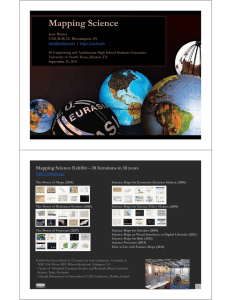
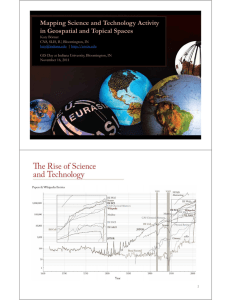
![Science Maps Explore New Ways of Displaying Information [Slide Show]](http://s2.studylib.net/store/data/010768709_1-3220b04c018450634153c8bae5b4b731-300x300.png)
